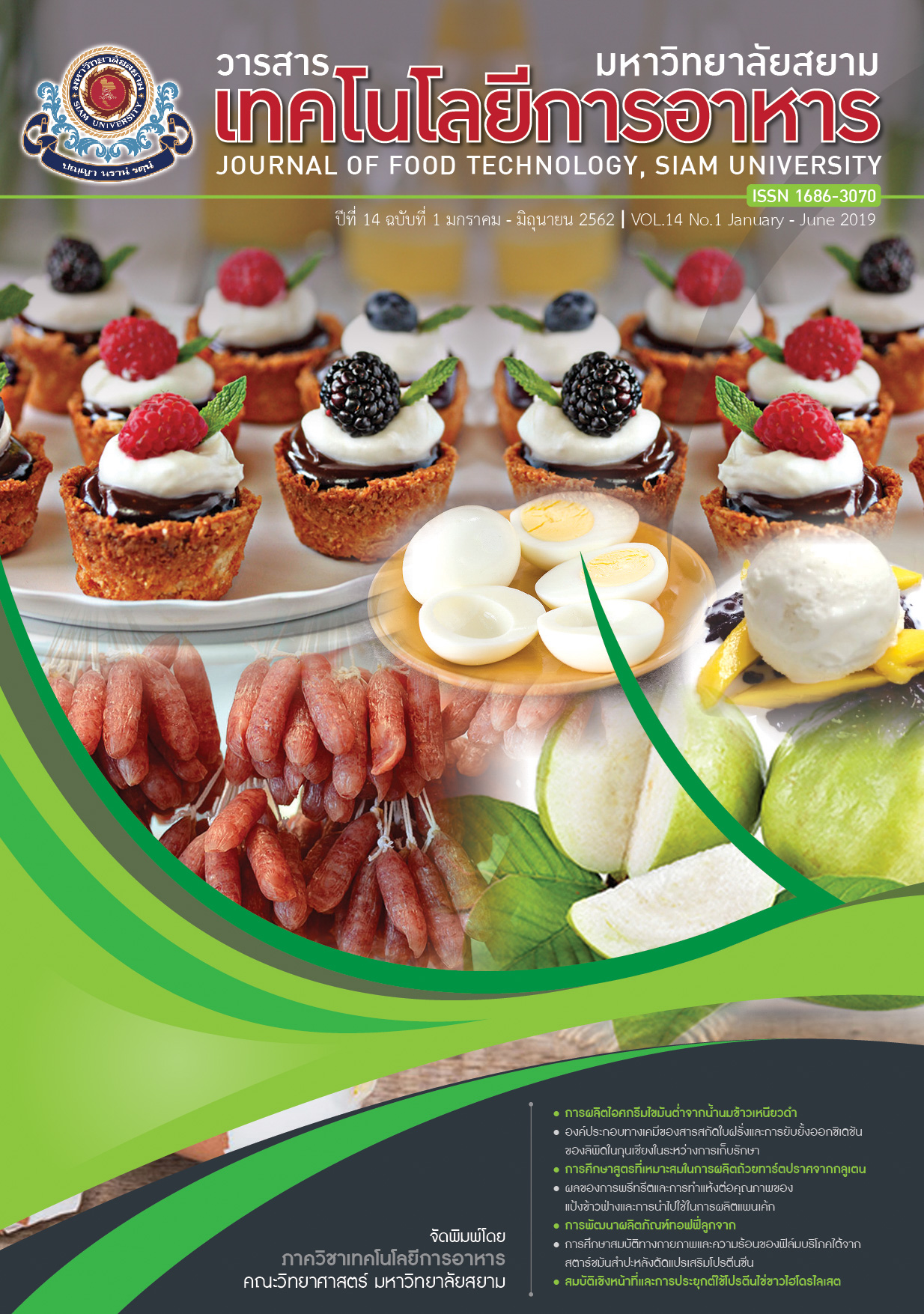Development of Nipa Palm Fruit Toffee Product
Main Article Content
Abstract
Nipa (Nypa fruticans) is one of mangrove species plant found growing in Phra Samut Chedi district, Samut Prakarn province. An unripe nipa endosperm is popularly consumed as fruit or food. However, an unripe nipa endosperm has a very high moisture content, thus potentially having a short shelf life of 2-3 hours at ambient temperature. The information on the uses of ripe nipa endosperm is also limited. This research aimed to study the five different appropriate ratios of unripe and ripe nipa palm at 100:0, 75:25, 50:50, 25:75 and 0:100 (w/w) on nipa palm fruit toffee product and analysis of product quality. The result indicated that an addition of ripe nipa endosperm affecting on increasing of L*, a*, b*, hardness, cohesiveness, and chewiness, while no significant difference of springiness (p>0.05). Sensory evaluation results showed a decreasing trend in texture scores (p≤0.05), while no significant difference in appearance and flavor score (p>0.05). The 3rd-formula nipa palm fruit toffee was obtained similar sensory scores to the 1st-formula (control). Therefore, the optimum formula of nipa palm fruit toffee consisted of 500 grams of unripe nipa palm, 500 grams of ripe nipa palm, 297.50 grams of sugar, 352.50 grams of glucose syrup, 150 grams of skim milk powder and 80 grams of salted butter. It had 85 ºBrix and 0.585 aw, respectively. Moisture content, carbohydrate, crude protein, total fat, ash and dietary fiber were 3.50%, 85.72%, 7.43%, 2.86%, 0.49%, and 4.45%, respectively. Moreover, the microbiological quality was complied with the Thai Community Product Standard (TCPS 265/2559; Toffee).
Article Details
Copyrights of all articles in the Journal of Food Technology available in print or online are owned by Siam University and protected by law.
References
[2] Osabor, V.N., Egbung, G.E. and Okafor, P.C. (2008). Chemical profile of Nypa fruiticans from Cross River Estuary, South Eastern Nigeria. Pakistan Journal of Nutrition. 7(1): 146-150.
[3] Hongwiwat, N. and Hongwiwat, T. (2007). Fruit 111 types: Nutritional value and consumption. (1st ed.). Bangkok: Sangdad.
[4] Booncham, S. (2015, May, 14). Interview. Chairman of the Community Enterprise Ban Khlong Na Kluea, Laem Fa Pha, Phra Samut Chedi, Samut Prakan.
[5] Ratanapanon, N. (2010). Food Chemistry.
(4th ed.). Bangkok: Odeon Store.
[6] Supaking, J. (2016). Production of osmotic dehydrated nipa palm. Complete Research Report. Dhonburi Rajabhat University, Bangkok, Thailand.
[7] Booncham, S. (2016, August, 21). Interview. Chairman of the Community Enterprise Ban Khlong Na Kluea, Laem Fa Pha, Phra Samut Chedi, Samut Prakan.
[8] Sum, P.C., Khoo, H.E. and Azlan, A. (2013). Comparison of nutrient composition of ripe and unripe fruits of Nypa fruticans. Fruits. 68(6): 491–498.
[9] Abdul-Hamid, A. and Luan, Y.S. (2000). Functional properties of dietary fibre prepared from defatted rice bran. Food Chemistry. 68(1): 15-9.
[10] Association of Official Analytical Chemists (AOAC International). (2000). Official methods of analysis. (17th ed.), Washington, D.C.
[11] Punjabute, N. (2012). Study on process conditions of mango toffee. Master’s thesis, King Mongkut's Institute of Technology Ladkrabang, Bangkok, Thailand.
[12] Sucheta. (2013). Development and evaluation of cheese and toffee from guava-mango blends. Master’s thesis, Chaudhary Charan Singh Haryana Agricultural University, Haryana, India.
[13] Department of Agricultural Extension. (2004). Durian products. [Online] Available from: https://chantrabook.files.wordpress.com/2015/09/000163.pdf [Accessed June, 24, 2016].
[14] Bunyapraphatsara, N., Srisukh, V., Jutiviboonsuk, A., Sornlek, P., Thongbainoi, W., Chuakul, W., Fong Harry, H.S., Pezzuto, J.M. and Kosmeder, J. (2002). Vegetables from the mangrove areas. Thai Journal of Phytopharmacy. 9(1): 1-12.
[15] Pornchaloempong, P. and Ratanapanon, N (n.d.). Dietary fiber. [Online] Available from: https://www. foodnetworksolution. com/wiki/word/1102/dietary-fiber [Accessed September, 5, 2016].
[16] Sombatpraiwan, S., Tipyavimol, T. and Treeamnuk, K. (2012). A study on ripening delay of Mangifera indica Linn. cv. Nam Dok Mai. Agricultural Science Journal. 43(3 special): 355-358.
[17] Teka, T.A. (2013). Analysis of the effect of maturity stage on the postharvest biochemical quality characteristics of tomato (Lycopersicon esculentum Mill.) fruit. International Research Journal of Pharmaceutical and Applied Sciences. 3(5): 180-186.
[18] Davies, C.G.A. and Labuza, T.P. (1992). The maillard reaction application to confectionery products. Department of Food Science and Nutrition, University of Minnesota.
[19] Subhimaros, S. (2000). Confectionery and Chocolate Technology. (1st ed.). Bangkok: Chulalongkorn University Printing House.
[20] Punjabute, N. and Huangrak, K. (2012). Study on mango varieties and optimum glucose syrup in mango toffee production. In Proceedings of The 2nd National and International Graduate Study Conference (IGSC 2012), pp 1016-1029. May 10-11, 2012. Nakhon Pathom. Thailand.
[21] Chavan, U.D., Shegade, S.L., Karma, B.R. and Dalvi, U.S. (2016). Studies on preparation of toffee from guava. International Journal of Advanced Research in Biological Sciences. 3(1): 99-111.
[22] Thai Industrial Standards Institute. (2016). Thai Community Product Standard (TCPS 265/2559; Toffee). Thai Industrial Standards Institute, Ministry of Industry.
[23] Sunta, R. (2008). Development of Longon chewy candy formulation. Master’s thesis, Chiangmai University, Chiangmai, Thailand.


